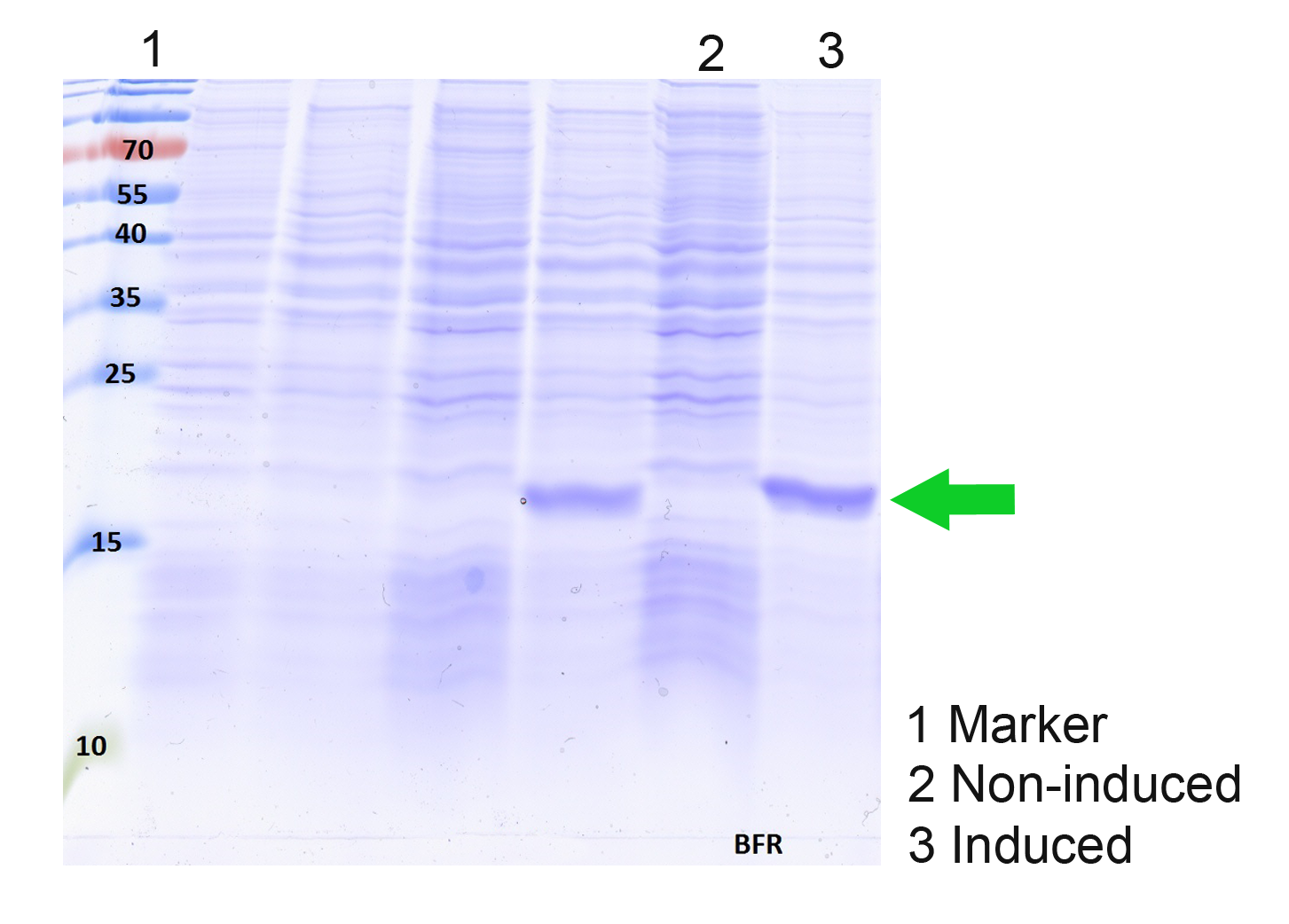Part:BBa_K1438000
Bacterioferritin (BFR)
Contents
Bacterioferritins and its properties
Iron Storaging Protein
Bacterioferritins are the E. coli cells natural iron storage proteins. These hollow nearly spherical protein shells detoxify the cell by sequestering excessive iron and forming Iron(III)hydroxid-oxide particels.
Bacterioferritin is an heam containing bacterial ferritin. Each heme is bound in a pocked formed by the interface between a pair of symmetry-related subunits [1]. However, it was investigated that these heme groups may be involved in the release of iron out of the ferritin iron core by forming an heme-mediated electron transfer to reduce immobilized Fe3+ to more soluble Fe2+.
We isolated this particular bacterioferritin from the probiotic strain E. coli Nissle 1917, which does have more iron aquisition systems than other well established E. coli strains. Our hyoothesis was that as E. coli Nissle is known to have a selection advantage because it is a very efficient iron sequesterer, it might have better evolved bacterioferritins. [3]
Bacterioferritins reveal to have the highest increase in iron capacity when compared to other ferritin species. [4]
Bacterioferritin as a mediator for magnetism in a cell
Bacterioferritins have been investigated regarding their magnetic character since the 80s. Bfr overexpressing E. coli Nissle 1917 - a strain with a low immunogenity- were previously used in studies as biological MRI contrast agents. [4] Furthermore, the magentic character of iron loading bacterioferritins were studied by Hawkins & Williams concluding that the contamination of the bacterioferritin iron core with phosphate reduces the super paramagnetic properties significantally. [5]
Usage and Biology
SDS PAGE
We succesfully expressed bacterioferritin in E. coli DH10b using our BFR expression Device BBa_K1438020
Improving BFRs Iron Storage Properties
We constructed a improved version of this protein by site-directed Mutagenesis (M52H) and added it to the parts registry as BBa_K1438001.
Furthermore we constructed the iGEM Ferritin library which consists of 6 different ferritin protein expression devices, which can be used by future generations of iGEM students to further works with ferritins as nanocages.
All of these parts are featured with an his-tag so purification and invitro studies may be conducted.
Quantification of Bacterioferritin mediated iron capacity increase
More iron can be stored inside of a cell that is overexpressing bacterioferritin.
References
[1] Frolow F, Kalb AJ, Yariv J. Structure of a unique twofold symmetric haem-binding site. Nat Struct Biol. 1994 Jul;1(7):453-60. PubMed PMID: 7664064.
[2] Yao H, Wang Y, Lovell S, Kumar R, Ruvinsky AM, Battaile KP, Vakser IA, Rivera M. The structure of the BfrB-Bfd complex reveals protein-protein interactions enabling iron release from bacterioferritin. J Am Chem Soc. 2012 Aug 15;134(32):13470-81. doi: 10.1021/ja305180n. Epub 2012 Aug 1. PubMed PMID: 22812654; PubMed Central PMCID: PMC3428730.
[3] Grosse C, Scherer J, Koch D, Otto M, Taudte N, Grass G. A new ferrous iron-uptake transporter, EfeU (YcdN), from Escherichia coli. Mol Microbiol. 2006 Oct;62(1):120-31. PubMed PMID: 16987175.
[4] Hill PJ, Stritzker J, Scadeng M, Geissinger U, Haddad D, Basse-Lüsebrink TC, Gbureck U, Jakob P, Szalay AA. Magnetic resonance imaging of tumors colonized with bacterial ferritin-expressing Escherichia coli. PLoS One. 2011;6(10):e25409. doi: 10.1371/journal.pone.0025409. Epub 2011 Oct 3. PubMed PMID: 21984917; PubMed Central PMCID: PMC3184983.
[5] Hawkins C, William J.M Mössbauer studies of superparamagnetism in E. coli.i. Journal of Magnetism and Magnetic Materials 104-107 (1992) 1549-1550 North-Holland Sequence and Features
- 10COMPATIBLE WITH RFC[10]
- 12COMPATIBLE WITH RFC[12]
- 21INCOMPATIBLE WITH RFC[21]Illegal BamHI site found at 34
- 23COMPATIBLE WITH RFC[23]
- 25COMPATIBLE WITH RFC[25]
- 1000INCOMPATIBLE WITH RFC[1000]Illegal BsaI site found at 142
//cds
//function/biosynthesis/heme
| protein | 19,7 kDa |


